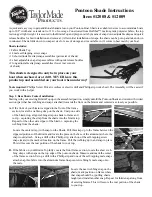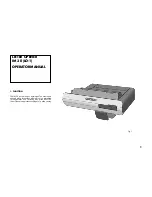
140.010-IOM (NOV 2019)
Page 32
IDSC EVAPORATIVE CONDENSERS
MAINTENANCE
rosion protection, but does require maintenance such as
cleaning or flushing when required to remove any sludge
accumulations and retard any biological growth.
The drift eliminators are constructed from heavy duty
PVC, are UV and corrosion resistant and aerodynamically
optimized to ensure zero moisture carryover from the
saturated discharge airstream.
NOTICE
Before any inspection or maintenance of the wa-
ter distribution system, ensure that all fan motors
are shut off, locked out and tagged out. The water
distribution pump must be left running in order to
thoroughly inspect and evaluate the effectiveness of
the water distribution system.
Removal of the drift eliminator sections provides access to
the water spray nozzles and allows for a clear view of the
water spray distribution pattern from each nozzle. Ensure
that the spray pattern from the nozzles are uniform and
validate that the entire plan area of the heat exchange coil
is being wetted. Remove and clean any nozzles which do
not produce a 360° spray pattern. Investigate any exces
-
sive sludge buildup in the spray branches and nozzles. This
could be due to the strainers not inserted correctly, or
being damaged.
When required, clean drift eliminators and inlet louvers
with a pressure washer, however do not use high pressure
or steam.
NOTICE
High pressure water or steam must never be used to
clean the PVC components within the IDSC unit for
example, drift eliminators, inlet louvers, water distri-
bution piping and the spray nozzles. High pressure or
steam must never be directed at motors. The mo-
tors must be suitably wrapped if any (high) pressure
cleaning is applied to the IDSC unit.
NOTICE
Before performing any maintenance, adjustment or
inspection of the electrical and mechanical compo-
nents, ensure that all power has been switched off,
locked out and tagged out.
WATER DISTRIBUTION PUMP
Record pressure readings from the pump discharge at the
time of startup and use, if required, for future reference.
When a remote sump is provided for the unit, ensure that
the pressure at the inlet to the supplied water pipe riser is
between 6 psig and 8 psig.
For electrical data, record voltage and amperage readings
and verify against original installation data.
Inspect the pumps on a regular basis for leaks and rectify
if required.
Inspect, lubricate, and maintain the pump and pump motor
in accordance with the manufacturers’ recommendations,
which are available upon request.
EC MOTORS
EC motors are essentially maintenance free.
Before connecting the power supply, ensure that the
supply voltage matches the operating voltage of the mo
-
tors. Ensure that the terminal box on the motor is tightly
secured and sealed and all cable glands are properly
tightened. Condensate discharge holes must always be
open. Ensure that these are not clogged with any debris
and clean if necessary.
It is not necessary to lubricate bearings. Bearings are
sealed and last the life of the motor.
WATER QUALITY AND WATER TREATMENT
GUIDELINES
NOTICE
It is strongly recommended to consult with a water
treatment service company with full service capabili-
ties before installation.
BLEED OR BLOW DOWN RATE
The thermodynamics behind evaporative cooling is such
that a portion of the recirculated water passing over
the heat exchange surface evaporates as it absorbs the
heat from the fluid being cooled. This process provides
the primary cooling effect. The heat is rejected into the
atmosphere as relatively warm, saturated air discharged
through the fan section.
However, only pure water evaporates which means that
any impurities in the makeup water remain in the recircu
-
lated water system. Depending on the location, it is also
possible that airborne impurities could be absorbed into
the recirculating water system.
The impurities and any airborne contaminants (dissolved
solids) remain in the water system. If not effectively con
-
trolled, they can lead to sludge accumulations, biological
growth, scale, fouling, and corrosion as their concentra
-
tion increases in the water distribution system.
To prevent these dissolved solids from overconcentrat
-
ing, a portion of the recirculating water system must be
drained from the system as a bleed or blow down. The
concentration level of these dissolved solids is referred to
as the cycles of concentration within the water distribution
system.
Cycles of
Concentration
=
Water Conductivity (in the evaporative unit)
Makeup Water Conductivity
The cycles of concentration equation reflects the degree
to which the dissolved solids in the makeup water are al
-
lowed to concentrate in the recirculating water system.
The higher this ratio, the more the dissolved solids in the
makeup water are allowed to concentrate in the water





































